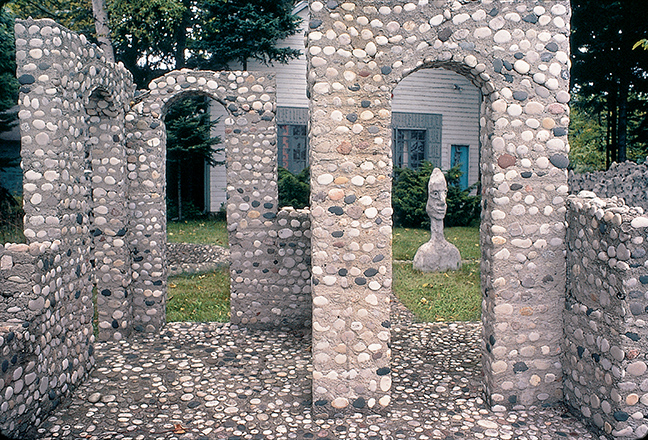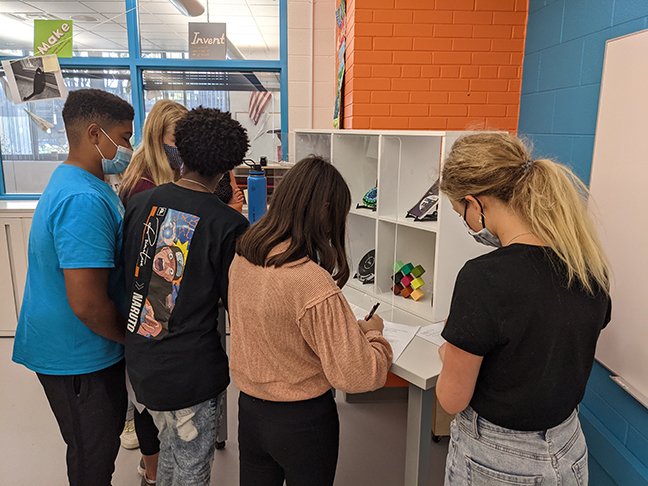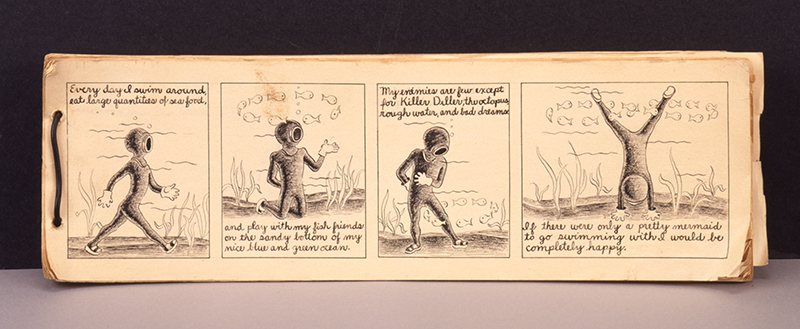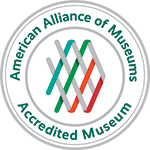Teaching Primary and Secondary Sources through Mary Nohl’s Life and Artwork

Lesson by Kris Lockhart, Talent and Development Coordinator
Brandon Blahnik, Social Studies Instructor: Bayside Middle School
Grades 6–8
Time to Complete: Two 70-minute class periods
Big Idea: Imagination
In this lesson, students will learn how to act like historians by learning to identify and analyze primary and secondary sources. They will explore how to use both types of sources to create historical arguments and support their arguments. Essential questions to be answered during this lesson will be: What are the differences between primary and secondary sources? How do primary and secondary sources help historians better understand a historical person or time period? Students will make inferences about Mary Nohl by viewing primary and secondary sources.
Additionally, students will consider what further sources would be needed to understand the historical context of her life. Students will select items from their own lives during the past year and bring them in for a primary source exhibit. Students will view the primary source exhibit acting like historians from the future and will draw conclusions about this time period supported by the evidence from the exhibit. Students’ learning will be debriefed through small and large group discussion. This lesson integrates learning about art, community, and social studies. It offers opportunities for discussions around Social Emotional Learning. The lesson can be used to launch work on a larger research project, such as National History Day.
Objectives
• Students will identify differences between primary and secondary sources.
• Students will make inferences based on a review of selected primary sources.
• Students will identify further primary and secondary sources needed to support their inferences and begin to build a historical argument.
Key Vocabulary
• Inference
• Primary Source
• Secondary Source
• Historical Argument
Discussion questions
• What inferences can you make about Mary Nohl by viewing primary and secondary sources related to her?
• What other information and sources do we need to gather and understand to make more informed inferences about Mary Nohl?
• What are the differences between primary and secondary sources? How do historians use primary and secondary sources through research?
• What lesson can we learn from how Mary Nohl lived her life and pursued her art?

Overview
Day 1
Students will view the contents of Mary Nohl’s desk drawer through a Google Slides presentation. Students will discuss items they notice and use the evidence to draw inferences about Mary Nohl. Students will then discuss what additional sources would be needed to further understand Mary Nohl. In partners, students will access the Nohl Desk Contents spreadsheet. Students will have five minutes to review the spreadsheet with a partner and discuss if this additional information helps confirm or change their original thoughts about the person who owns the desk drawer. Through a whole-class discussion, have partners share out answers to the prompts or items they found most interesting in the drawer. Items to highlight if not brought up (but will likely be brought up): Line 36: Mary Nohl’s Jewelry Stamp as it informs the viewer that she made jewelry and marked it as is common for people selling their art, Line 122: Foreign Paper Money and Line 155-161: Hotel Stationery. Both are indications that Mary Nohl travelled widely.
Next, review Primary Sources versus Secondary Sources using the resources developed by the Wisconsin Historical Society website. Use the Source Practice from the Wisconsin Historical Society to assess understanding. What type of source is the picture of Mary Nohl’s desk drawer? What type of source is the Nohl Desk Contents spreadsheet?
Explain that students will be looking at other primary sources to learn more about Mary Nohl and how to use primary sources. Show students the images of Mary Nohl’s artwork and residence to provide more context for students to view the primary source letters. Share basic information about Mary Nohl but resist the urge to tell students too much information at this point. The goal is to have them develop their own understanding about Mary Nohl by reviewing primary sources.
Review of Newsletters: Divide students into small groups (two to four students) and assign each group a newsletter to read and complete the Mary Nohl Questions. After 30 minutes, have students share what they learned about Mary Nohl and what further information would be needed to fully understand her and the impact of the events of that time period on her art and life. Invite students to share what lessons we can learn from Mary Nohl and how she lived her life. If not brought up by students, prompt them to think about perseverance, empathy, and the importance of perspective. *If time permits, have students read and discuss “The Legacy of Fox Point’s Mary Nohl” by the Shepherd Express. Students should identify how their inferences about Mary Nohl were confirmed or challenged by the article. At the conclusion of this part of the lesson, students should be able to define primary and secondary sources and explain how historical research relies on both types of sources.
Homework: Every student must bring in one item that was important to them in or they feel represented the previous school year. A few caveats: Items should be school appropriate, not living, something they are willing to share, and not too valuable. Students may bring in a printed picture of the item if it is too valuable or living.
Prep between this lesson and the second lesson: Collect the students’ items. Display the items as if in an exhibit that allows students to view the items freely.
A couple of recommendations: Have student leaders aid in creating the exhibit. Resist the urge to group primary sources into categories. Find a good way to display pictures that allows students to readily see and move about the items. (We had yarn strung across the room in two different sections so that students could hang their pictures.) We put all items behind plexiglass dividers (since we have so many!) to give students the sense that this was an exhibit and discourage them from handling the items.
Day 2
How do we make sense out of primary sources? Divide students into groups of three to four. Review the Primary Source Exploration activity with the students. Allow 10–15 minutes for the students to walk through the exhibit and discuss findings with the group. Then give students 10 minutes in their groups to discuss and answer the questions on the primary source exploration. Have students share with classmates one conclusion their group made. Discuss the variety of conclusions made through class discussion. Make connections for students about the importance of finding primary and secondary sources when researching historical topics and events.
Potential discussion questions: What events from the previous year are not represented? What secondary sources would students have to locate to build a historical argument? Why don’t all the groups have the same interpretation given that they all viewed the same items?

Extension opportunities:
Archiving activity: Interested students will be given the opportunity, time, and resources to digitally archive the artifacts brought in by students for the Primary Source exhibit. Students will plan how to complete this work. For example, they may choose to interview each student about why they selected their artifact and then create a book, website, or documentary to share the information they’ve collected and organized.
Provide students the opportunity to tour the John Michael Kohler Arts Center’s Art Preserve to view Mary Nohl’s collection.
Standards
National C3 standard connection and WI Social Studies Standards
Standard SS.Inq1: Wisconsin students will construct meaningful questions that initiate an inquiry
SSS.Inq1.a.m Formulate open-ended questions for further research within one of the social studies disciplines.
SS.Inq1.b.m Identify additional questions that support the research and possible resources to guide the inquiry.
Standard SS.Inq2: Wisconsin students will gather and evaluate sources
SS.Inq2.a.m Explore evidence from multiple reliable sources representing a range of perspectives and media that have been selected through research to guide the inquiry.
SS.Inq2.b.m Determine credibility and applicability of a source by considering a variety of factors through the lens of a social studies strand.
Standard SS.Inq3: Wisconsin students will develop claims using evidence to support reasoning.
SS.Inq3.a.m Develop a debatable and defensible claim based upon the analysis of sources
Support a claim with evidence from multiple reliable sources representing a range of media (electronic, digital, print, and other mass media).
SS.Inq3.c.m Analyze the extent to which evidence supports or does not support a claim, and if it does not, adjust the claim appropriately.
Standard SS.Inq4: Wisconsin students will communicate and critique conclusions
SS.Inq4.b.m Analyze and evaluate the logic, relevance, and accuracy of others’ claims, taking into consideration potential bias.
Standard SS.Inq5: Wisconsin students will be civically engaged.
SS.Inq5.a.m Explore opportunities for personal or collaborative civic engagement with community, school, state, tribal, national, and/or global implications.
CCSS.ELA-LITERACY.RH.6-8.1
Cite specific textual evidence to support analysis of primary and secondary sources.
CCSS.ELA-LITERACY.RH.6-8.2
Determine the central ideas or information of a primary or secondary source; provide an accurate summary of the source distinct from prior knowledge or opinions.
CCSS.ELA-LITERACY.RH.6-8.4
Determine the meaning of words and phrases as they are used in a text, including vocabulary specific to domains related to history/social studies.
CCSS.ELA-LITERACY.RH.6-8.6
Identify aspects of a text that reveal an author’s point of view or purpose (e.g., loaded language, inclusion or avoidance of particular facts).
CCSS.ELA-LITERACY.RH.6-8.7
Integrate visual information (e.g., in charts, graphs, photographs, videos, or maps) with other information in print and digital texts.




